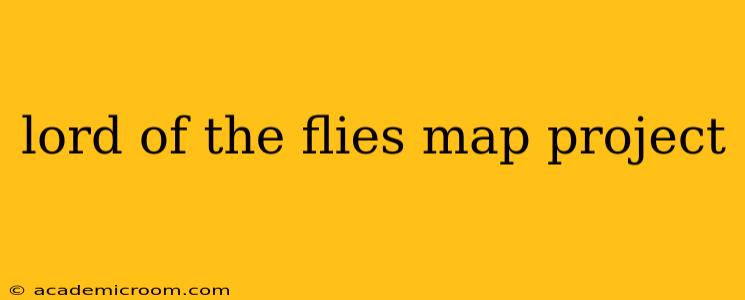The island in William Golding's Lord of the Flies is more than just a setting; it's a character in itself, reflecting the boys' descent into savagery. A map project based on the novel offers a unique opportunity to explore the physical space and its symbolic significance, going beyond a simple geographical representation. This exploration will delve into creating a comprehensive map, incorporating details from the text and considering the various interpretations of the island's landscape.
What are the key features of the Lord of the Flies island?
This question lies at the heart of any successful map project. Golding's descriptions are deliberately vague, leaving much to the reader's imagination. However, several key features emerge repeatedly:
- The Beach: The initial landing point, a place of relative safety and order before the boys' descent into chaos. Its location and characteristics (sandy, rocky, sheltered etc.) should be clearly marked on your map.
- The Mountain (Castle Rock): A prominent landmark, representing both a potential refuge and a site of escalating violence. Its height, steepness, and surrounding terrain should be noted.
- The Forest: A vast and largely unexplored area, symbolizing the wild and the unknown. Different sections could be labeled based on descriptions in the book (e.g., "thick jungle," "open glade").
- The Lagoon: The body of water surrounding the island, offering both potential for escape and a source of food. Its depth, currents, and accessibility should be considered.
- Piggy's Spectacles: Not a geographical feature per se, but absolutely crucial. Mark the locations where Piggy's spectacles are lost, found, or broken – they are a potent symbol of reason and civilization's fragility.
How can I accurately represent the island's geography in my map?
The lack of precise geographical details in the novel allows for creative interpretation. Your map should reflect your understanding of the text while staying true to its overall spirit. Consider:
- Scale and Perspective: Decide on a suitable scale for your map. Will it be a detailed topographic map, a more schematic representation, or something in between? Choose a perspective (bird's-eye view, isometric, etc.) that best suits your vision.
- Symbolic Representation: Don't be afraid to use symbols and color-coding to represent different areas and their significance (e.g., green for lush vegetation, brown for rocky areas, red for sites of violence).
- Key Locations: Mark all the significant locations mentioned in the book: the initial landing site, the mountain, the forest, the lagoon, the sites of key events (the fire, the death of Piggy, etc.).
What are some important considerations for a Lord of the Flies map project?
Creating a truly effective map requires careful consideration beyond mere geographical representation.
- Thematic Elements: The island's geography directly reflects the novel's themes. Consider how your map can visually represent concepts like order versus chaos, civilization versus savagery, and the loss of innocence.
- Character Movement: Chart the movements of the main characters throughout the story. This will provide a dynamic dimension to your map, highlighting the island's role in shaping their actions.
- Symbolic Interpretations: Different readers will interpret the island's geography differently. Your map should reflect your own understanding of these symbols and their importance within the context of the novel.
How can I make my Lord of the Flies map project unique and engaging?
To make your project stand out, consider these ideas:
- 3D Model: Create a three-dimensional model of the island, allowing for a more immersive and engaging representation.
- Interactive Map: Develop an interactive digital map that allows users to click on different locations and learn more about their significance within the story.
- Comparative Maps: Compare your interpretation of the island's geography with other interpretations found online or in critical essays. This demonstrates a broader understanding of the topic.
By meticulously considering these aspects, your Lord of the Flies map project will transcend a simple geographical exercise, becoming a powerful visual representation of Golding's masterpiece and your own insightful interpretation of its complex themes. Remember, the best maps are those that tell a story. Let your map tell the story of Lord of the Flies.
